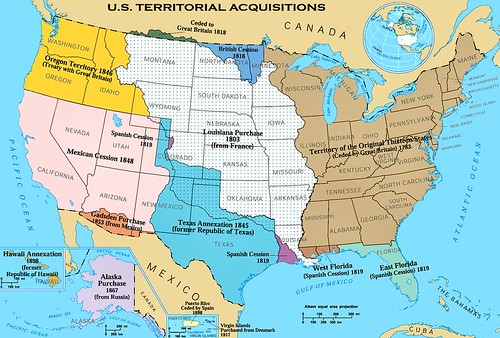We tend to think that everybody knows the difference between a state and a territory, but sometimes we get comments that show us we’re wrong about that. This morning, we saw this comment:
“No! Allow them to govern themselves, without interference! The same goes for Hawai’I and the other so-called territories.”
Let’s leave aside the question of self-governance and focus on “Hawaii and other so-called territories.”
Nobody calls Hawaii a territory. This is because Hawaii is a state.
What are the territories?
The United States has fourteen territories.
Inhabited Territories:
- American Samoa
- Guam
- Northern Mariana Islands
- Puerto Rico
- U.S. Virgin Islands
Uninhabited Territories:
- Baker Island
- Howland Island
- Jarvis Island
- Johnston Atoll
- Kingman Reef
- Midway Atoll
- Palmyra Atoll
- Serranilla Bank
- Wake Island
These are not “so-called” territories. They are territories, which is to say they are pieces of land belonging to the United States, which are not states.
There are also a few disputed territories: pieces of land which the United States claims but which another nation also claims. These include Bajo Nuevo Bank, also known as the Petrel Islands, which is administered by Columbia but claimed by both the U.S. and Jamaica. Navassa Island is claimed by the U.S. and Haiti. Serranilla Bank and Wake Island are also disputed.
See maps of all these territories at Geology.com.
What about the states?
There are 50 states in the United States:
- Alabama
- Alaska
- Arizona
- Arkansas
- California
- Colorado
- Connecticut
- Delaware
- Florida
- Georgia
- Hawaii
- Idaho
- Illinois
- Indiana
- Iowa
- Kansas
- Kentucky
- Louisiana
- Maine
- Maryland
- Massachusetts
- Michigan
- Minnesota
- Mississippi
- Missouri
- Montana
- Nebraska
- Nevada
- New Hampshire
- New Jersey
- New Mexico
- New York
- North Carolina
- North Dakota
- Ohio
- Oklahoma
- Oregon
- Pennsylvania
- Rhode Island
- South Carolina
- South Dakota
- Tennessee
- Texas
- Utah
- Vermont
- Virginia
- Washington
- West Virginia
- Wisconsin
- Wyoming
Note that Hawaii is on that list. Hawaii achieved statehood in 1959 after a long time as a territory.
What’s the difference?
States have sovereignty and rights under the U.S. Constitution. They are all equal and must be treated equally, again under the Constitution.
Territories can be treated differently from states and differently from one another. Thus, some territories get more federal benefits or different sets of federal benefits from the others. Not all the residents of all the territories are citizens. Residents of the territories, even if they are citizens, cannot vote in presidential elections and do not have any senators. They have only limited representation in the House of Representatives. Territories, and the residents of territories, are not fully protected by the Constitution as states and the residents of states are.
Being a territory is very different from being a state. We hear from people who think that Puerto Rico is already a state, and from at least one person who thinks Hawaii is a territory. It’s important to know the difference.
32 territories have already become states. It’s long past time for Puerto Rico to join them as the 51st state. Contact your congressional representatives and let them know that you support statehood for Puerto Rico.








No responses yet